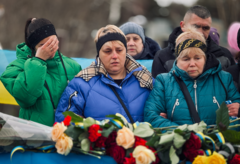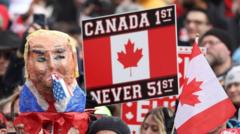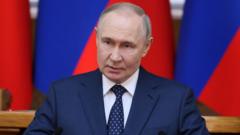Ukrainians in Malokaterynivka express concern over President Trump's strategy for ending the war; they dread the implications of a ceasefire that could favor Russia while leaving them vulnerable.
Trump's Peace Plan Sparks Unease Among Ukrainians

Trump's Peace Plan Sparks Unease Among Ukrainians
Trump aims for peace in Ukraine, but locals fear potential consequences.
Oleksandr Bezhan stands beside a barren paddock where his fishing business once thrived, staring into a future that seems more uncertain than ever. "If I wake up in the morning, that’s already pretty good," he reflects, underscoring the grim reality faced by those near the front line in Ukraine's Zaporizhzhia region. This village, just 15km (9 miles) from active conflict, is caught in a freeze, both physically and metaphorically.
After a series of military campaigns that once reignited hopes for victory, the situation has stagnated as Russian artillery continues to dominate. Following the destruction of the Kakhovka dam, the landscape around here is desolate, stripped of life and optimism. While both the U.S. and Ukraine echo desires for peace, the pathway remains littered with differing visions. Many fear that any ceasefire could solidify the current territorial gains by Russia, which they perceive as a dangerous precedent.
President Trump’s recent rhetoric might suggest an end to hostilities, but for locals like Oleksandr, there is only deep apprehension. "If the front lines become permanent borders, it could ignite fresh fighting at any moment," he warns as he gazes across at the Russian-held areas. The fallout from unresolved conflicts looms large; with half the cemetery in Malokaterynivka filled with freshly dug graves, it is clear the human cost continues to rise.
As communities band together to mourn their losses, sentiments of betrayal circulate. Many question the direction of Ukrainian leadership and its relationship with allies, with the hope for credible security assurances fading. “It probably won’t work out, but Seoul is 30km from North Korea, and they manage to thrive,” Oleksandr reflects, suggesting only a slim possibility of coexistence.
Funerals in this community are punctuated by artillery threats, relegating mourners to a brief 25-minute goodbye as they duck in fear of incoming fire. Natalya, widowed and heartbroken, states, “I don’t expect a ceasefire, but I hope to be proven wrong.” Despite the dismal climate, she shares a longing for peace, one many in the area share.
As the elderly Lyudmyla gazes upon the abandoned rail lines leading to Crimea—now occupied by Russia—hope remains fragile yet persistent. “We want to believe,” she states, her breath heavy with the weight of uncertainty. While the Syrian sirens echo through her memories, the dream of restored ties with Crimea feels distant.
Overall, Ukrainians long for a peace that seems tantalizingly close yet impossibly out of reach. The possible absence of war brings hope for quiet nights and returning soldiers, but mistrust shadows every solution whispered about in high-profile negotiations. They know that while peace is sought, the devil will lie in the details—details that both Kyiv and Moscow remain eager to negotiate in their own favor.























